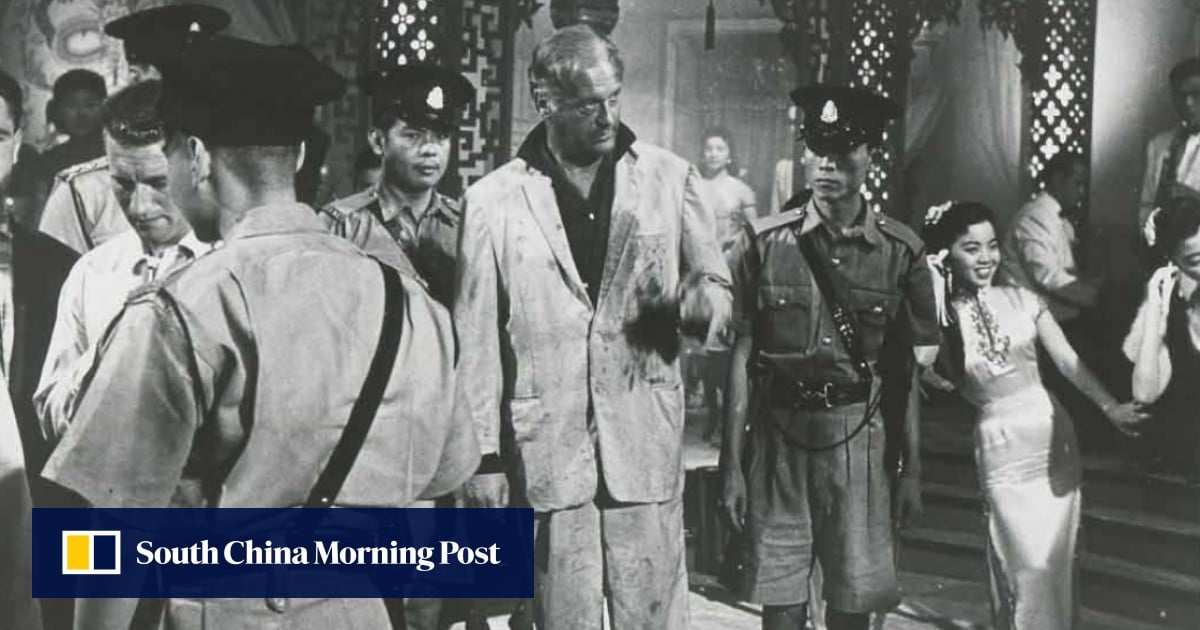Shot in expensive CinemaScope widescreen entirely on location, it was the Rank studio’s most ambitious project to date, even if, viewed today, it feels like a picture postcard from another era.
The story concerns Mark Conrad (Curt Jürgens), a down-on-his-luck drinker and gambler who gets expelled from Hong Kong after a bar fight.
Forced to take an ancient steamer called the Fa Tsan (or “Fat Annie”) to Macau, he is refused entry there as well, and finds himself stuck, travelling back and forth between the two islands for months, much to the chagrin of Captain Cecil Hart (Orson Welles).
On board, he makes friends with the crew, including engineer Joe Skinner (Noel Purcell), and romances the much younger teacher Miss Ferrers (Sylvia Syms), while gradually making himself at home.
After plenty of high-seas drama, not least being captured by pirates, the Fat Annie is eventually sunk, but not before Conrad has redeemed himself.
As one commentator noted, the film is part Casablanca – on a very bad day – and part The World of Suzie Wong.

While it is impossible to imagine quite how exotic Hong Kong must have appeared to British cinema-goers in the late 1950s, the location work still has its charms.
There are beautiful shots of the Fat Annie towering over junks in the harbour with a dramatic sunset behind; views from The Peak of a bewilderingly low-rise Central; and plenty of sailing sequences that feature Hong Kong’s smaller islands shimmering in the distance.
Not that the shoot was plain sailing for Gilbert, who referred to the project as “my nightmare film” on BBC radio programme Desert Island Discs.
“Everything was wrong,” he elaborated, “principally Orson Welles.”
Welles, who had been in decline since his stellar 1941 debut in Citizen Kane, was apparently jealous of Jürgens’ popularity, and repeatedly held up filming with his unprofessional behaviour.
It was, Gilbert admitted, a “battle to get him on the floor” every day – and not necessarily a battle worth fighting.

Whatever you make of the film, the casting almost scuppers it. As the obsequious captain, Welles gives an overly broad performance, with a wobbly English accent that is part Kenneth Williams and part Sid James.
It does not help that the dialogue was re-recorded back in England, making it seem like it had been dubbed by different actors.
Jürgens is equally miscast. With his strong German accent and stern bearing, he is more commanding than charming, closer to the Bond villain he would play in Gilbert’s The Spy Who Loved Me (1977) than a romantic lead.
Indeed, quite why the young, beautiful Miss Ferrers would fall for a grumpy middle-aged loser like Conrad is a greater mystery than anything served up by the plot.
Although the film falls prey to the usual racist clichés, depicting the Chinese as either silent, staring hordes or criminals, it is an otherwise genial way to pass two hours.

But the real interest lies not in the story, but what is going on beneath the surface.
During the post-war period, cinema was not the only thing reinventing itself. Britain was still trying to find its place in the modern world. The 1956 Suez Crisis had seen it embarrassed by the United States and the Soviet Union, and it would play a much smaller part in the ensuing Cold War than previous conflicts.
Faced with its own declining imperial power, Britain considered Hong Kong a prized possession, although one that was increasingly vulnerable to communist China.
The film, therefore, can be seen as nostalgia for the days when Britain did indeed rule the waves – there is even a small group of Chinese musicians playing Rule, Britannia! from a sampan as Conrad romances Miss Ferrer.

It also acknowledges that the times are changing. The Fat Annie may once have ruled the waves, but she is old and outdated, and equally vulnerable to Chinese pirates. When we last see her, she is sinking in the South China Sea as Hong Kong life moves on around her.
But then, as Miss Ferrers reminds us, “Not all stories have a happy ending.”

